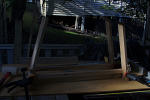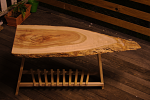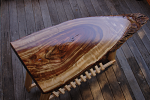Here is the most recent coffee table I have finished. It is being picked up tomorrow, and I am pretty pleased with the result. I cut my thumb nearly 8 weeks ago, but those who frequent the tools forum may remember a question I asked back then about 15 degree mortises. That was for this project. I wanted the legs at 15 degrees to the table to increase rigidity. The first few images show what I ended up doing for that. In brief, I cut the mortise at 90 degrees but about 3 times as wide as the tenon needed to be. I also cut a filler block to go in the gap. The filler block was split down the middle at 15 degrees, and the tenon was put in between the two pieces. Photos 1, 2 and 3 show this process.
Photos 4, 5 are the frame and magazine rack. Photo 6 is the table assembled but not varnished.
Photos 7, 8, 9 are after varnishing. I used Cabothane thinned 50/50 and sprayed on with an air brush. 3 coats on the frame and 8 coats on the table top itself. As you can see from the reflection of the glass in the table top, it came up as a pretty good semi-gloss finish.
Almost forgot, the timber is Camphor Laurel and Pine for the frame.
Darryl
Photos 4, 5 are the frame and magazine rack. Photo 6 is the table assembled but not varnished.
Photos 7, 8, 9 are after varnishing. I used Cabothane thinned 50/50 and sprayed on with an air brush. 3 coats on the frame and 8 coats on the table top itself. As you can see from the reflection of the glass in the table top, it came up as a pretty good semi-gloss finish.
Almost forgot, the timber is Camphor Laurel and Pine for the frame.
Darryl













